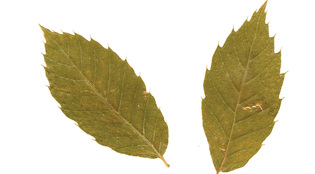 loading
loading
Light & VerityAn American classic in Yale's forest Before they were beset by blight, 20 percent of the trees east of the Mississippi were American chestnuts. View full image
At the beginning of the last century, in just a few decades, the American chestnut virtually vanished. Once the mainstay of the Appalachian forest—one in every five trees east of the Mississippi River was a chestnut—the species fell victim to a blight that started its sweep in 1904 and killed almost every chestnut in 200 million acres from Maine to Mississippi. Today, that story is being rewritten at the Yale-Myers forest in northeastern Connecticut, among several other experimental sites in eastern U.S. forests. Last year at the Yale forest, Leila Pinchot '08MF began planting chestnuts bred specifically to resist the blight. "We're planting to gain a better understanding about how to manage sites for successful restoration of the species," says Pinchot, a forest ecologist. She is monitoring the seedlings to record their progress. If scientists can unlock the secrets of chestnut ecology, she says, the species may reclaim its place in the American woods. Pinchot has joined a bold and ambitious effort at ecological restoration. But really, she's joining the family business. Her great-grandfather Gifford Pinchot, Class of 1889, founded the Yale School of Forestry and Environmental Studies and became the first chief of the U.S. Forest Service. He made forest conservation a core mission of stewardship of public lands. A yet unknown number of the 436 seedlings planted in Yale-Myers are resistant to the Asian fungus Cryphonectria parasitica, whose cankerous growths choke off the tree's nutrients and water. Sandra Anagnostakis, a leading chestnut researcher at the Connecticut Agricultural Experiment Station, bred the trees using cross-pollination to produce American chestnuts armed with a tiny cluster of genes, from a Chinese variety, that provide blight resistance. But it's a genetic roll of the dice: only a certain percentage of each generation inherits the correct DNA. The only way to know for sure is to plant them out in the wild. The experiment run by Pinchot, now a doctoral candidate at the University of Tennessee, is part of a national collaboration. The Connecticut Agricultural Experiment Station supplied Yale's trees. The American Chestnut Foundation has chapters all over the eastern United States. The U.S. Forest Service is growing thousands of new seedlings to plant in the Appalachians, whose hillsides and valleys once lay inches deep in the nuts that dropped from American chestnuts every fall. The test will come in the next few years. As the trees grow, many will succumb to the blight, to hungry deer, to gall wasps, and to new invasive diseases. In the Yale-Myers forest, Pinchot reports, only 35 percent of the seedlings are still standing; most were nibbled down to nubs by hungry deer. Still others will fall to the blight. Pinchot is undeterred. "What I think of as success is chestnuts starting to reproduce and evolve on their own. It's going to be a couple of hundred years before that happens. But we can start planting now, knowing future generations will reap the benefits from it. It's really not hard to get excited about the chestnut."
The comment period has expired.
|
|